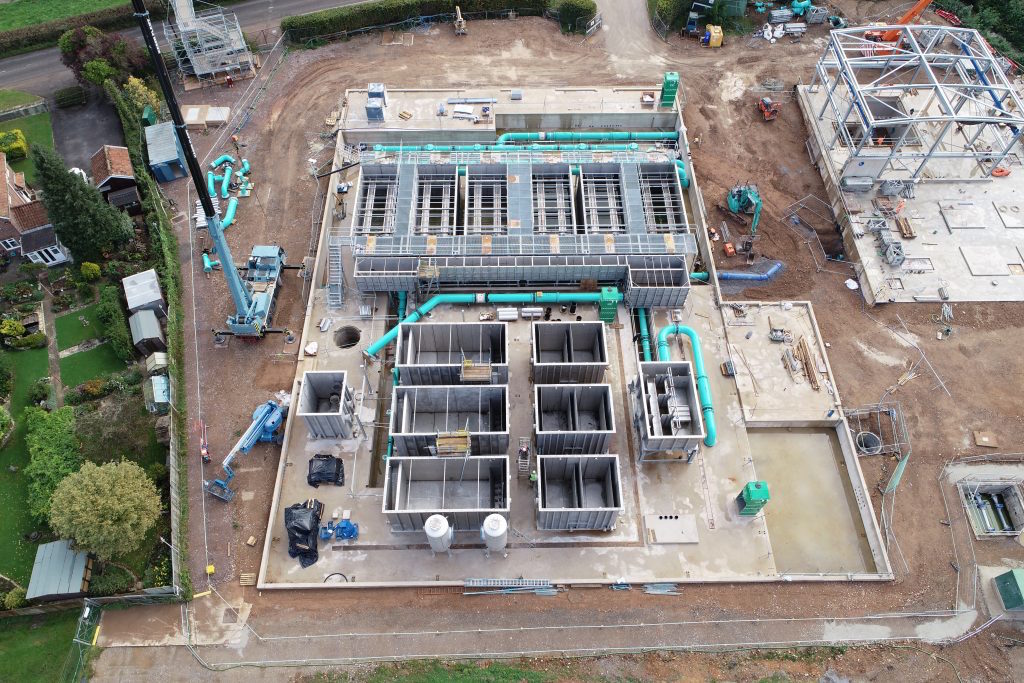
Wessex Water is looking to harness more construction data as it gears up to maximise efficiency in a boosted investment programme. Denise Chevin spoke to Adam Bear, Wessex Water’s strategic digital manager.
Wessex Water has been using common data environment (CDE) software, to improve efficiencies in its design and construction work. The regional water and waste water company has already invested more than £1bn in construction since 2020. The cloud-based solution has been helping project teams work effectively in a collaborative environment, from conceptual design through construction and ultimately project handover.
With increasing pressure on water companies to boost investment in their assets while keeping bills down, strategic digital manager Adam Bear believes there is more innovation to come. Wessex Water’s in-house digital engineering team is looking to hone its digital requirements in contracts with suppliers, so they harvest the correct data to streamline maintenance operations.
Bear trained as an architect before joining Wessex Water at the end of 2018 as its strategic digital manager. He already had considerable experience in this area working for architectural practices.
“When I joined Wessex Water in 2018, there were pockets of innovative working within a digital engineering environment. However, many of them were being used in analogue ways,” he says. “Wessex Water recognised that a CDE would help improve communication and efficiency by creating a single source of truth for all project data.”
BIMplus: How has the CDE helped?
Adam Bear: The technology we had been using had a convoluted way of setting projects up and could take two or three days. We found we could set up projects in the cloud in two or three minutes, so we instantly saw the benefits from the solution.
Integrating with other products also allows more team members to access project data easily. This proved critical during lockdown, when used in combination with Microsoft Teams (which had also been introduced at the same time) allowed design review sessions to be carried out remotely. While not a full substitute for face-to-face design reviews, it’s still a tool that people find very useful for reviewing information and going through approval processes.
Durleigh Water Treatment Centre
The new approach came into its own on the £50m refurbishment of the Durleigh Water Treatment Centre in Somerset, which began in 2019 and was completed in the autumn of 2022 – the largest single-value project ever delivered by Wessex Water’s Sustainable Operations and Engineering team. One of the main benefits of using digital design flows was in enabling greater certainty during offsite manufacture and modular construction.
The 3D model gave improved project and asset information accuracy on delivery timeline and therefore improved risk management.
The 3D model provided a visual basis for improved access lifting and maintenance reviews during the design stage.
Wessex Water partnered with infrastructure consulting firm Aecom, which delivered the detailed design. Aecom established large structures and tanks that could be built offsite and craned into position, saving an estimated 20% programme time and £1.1m of costs, as well as reducing construction waste on site by up to 20%.
The success of the Durleigh project has resulted in the creation of a dedicated offsite build department at Wessex Water, at which equipment can be designed, manufactured and supplied pre-assembled, reducing labour, carbon footprint and costs.
Wessex Water now uses a standardised CDE on all new projects.
What will change going forward?
We are growing our in-house team, as well as working with the supply chain to fully explore the benefits digital engineering can bring.
The next investment cycle starts in April 2025 (Ofwat’s next price control period for water companies’ investment). Wessex Water, like other water companies, is expected to grow significantly as we look to reduce our use of storm overflows. This means Wessex Water will look to outsource more work to the supply chain.
An overall digital strategy that defines the role of data within a BIM process is our next phase of work. Recently Wessex Water has merged the operational and engineering teams, which has given us a much wider scope to look at the data that we produce during the design, construction and commissioning. We can now really examine what is the best way of handling that data, so that we can bring maximum benefit to the operational side of the business.
For example, the use of intelligent process and instrumentation diagrams (P&ID) can link straight into the operations work planning platforms, to aid the build-up of operational maintenance and asset replacement budgets and plans.
This capturing, managing and exchanging of accurate and up-to-date project asset information seamlessly from project conception, all the way through to asset maintenance, is fundamental to this strategy.
We always knew what the asset information requirements were at the end of the project and what we needed to hand over. But what we weren’t thinking about is all the asset information that we have during the project.
We’re now looking at the way in which we generate that asset data in the first place. So we are using tools where you actually go through the design producing a schematic of the process, like a flowchart.
The software is able to generate a library of all the symbols that you want to use to represent assets. The real game changer is the way in which the software also holds the asset data about each individual symbol that you placed in the schematic drawing.

‘We are growing our in-house team as well as working with the supply chain to fully explore the benefits digital engineering can bring’
So the developed design has all your graphical information and all your scheduling information in the same location, and then you can work on it in the same place.
This enables the construction teams to order materials, including fabrication packages prior to arriving on site and without the need to fully appreciate the project detail and programme.
When you come to handover, you can export it from a single location. You could start by exporting it to a spreadsheet format, then hand it over to an asset data team, and they can register it into our asset data software.
That’s very similar to how you might work in other BIM software. You’re not just producing drawings of things, you’re producing a database of elements, so you’ve got a coordinated set of graphical information and a coordinated set of schedule information.
But we’re trying to move on to the next step, where we say: ‘If you’ve got all of that information in these datasets, are there not ways that instead of handing over a PDF to an asset data team, could you hand over the data in a format that they can use in a better way? Can you hand over a spreadsheet? Or can you hand it over with APIs?’
What information would you want to extract?
‘We need to make sure that the asset data we have is of a very high standard, and ensure it’s updated in a timely manner’
A really simple example could just be the warranty information around an asset. One of the assets that we specify a lot are pumps. We buy them in bulk. One of the things we might want to know is the warranty details of those individual assets. So if they need to be maintained, if there’s a date at which the warranty expires, we’re going to want to know those dates, so they can inform our maintenance schedule.
And previously, this might be something that had been discovered after a handover. It wouldn’t be until they’ve been operated for a number of months that you come to realise that the warranty is only going to be valid for another six months.
We need to make sure that the asset data we have is of a very high standard, and ensure it’s updated in a timely manner. It’s no use for someone to look at a database of assets and find it outdated.
Is there anything that you’re expecting your partners to do differently?
Our next step is make sure that all the data that we’ve got as part of the design process is seamlessly fed into the operational side of the business, so that it can be used to drive the decisions on risk and investment that are going to affect customers over the next 20 to 50 years.
As part of that, we will be asking our suppliers to provide more asset data throughout the project cycle and not just at the end.
I’m a great fan of the way that Heathrow Airport operates in its contracts. The contracts explicitly state that you don’t get paid for delivering the asset, you get paid for delivering the asset data. And what you have actually built is almost a side effect of the asset data that you’ve provided. I don’t think we’re going to be able to go as far as that. It’s definitely a desired direction to make sure that the asset data is of equal importance.
Don’t miss out on BIM and digital construction news: sign up to receive the BIMplus newsletter.














